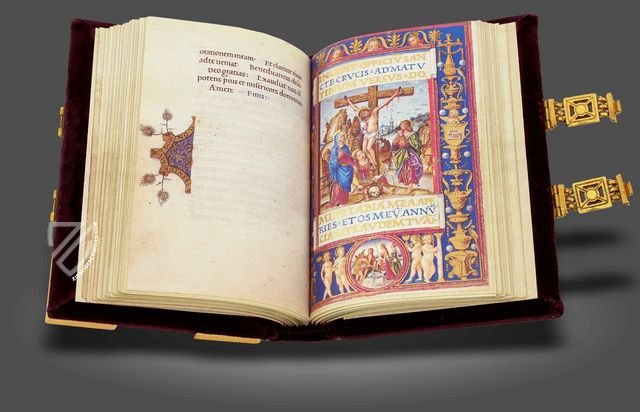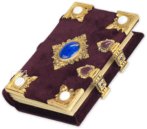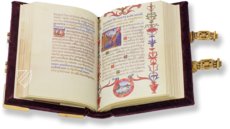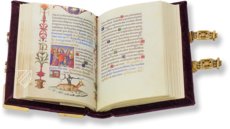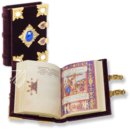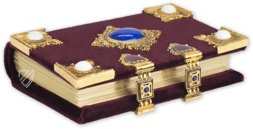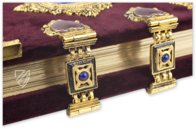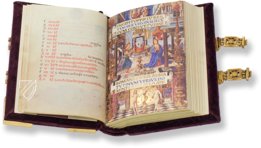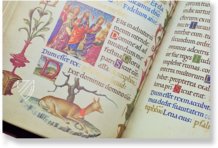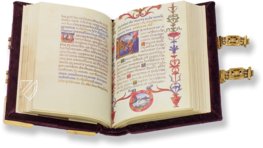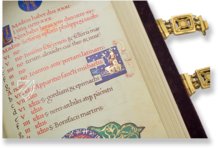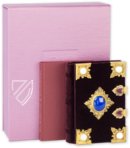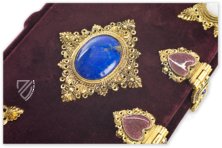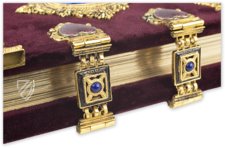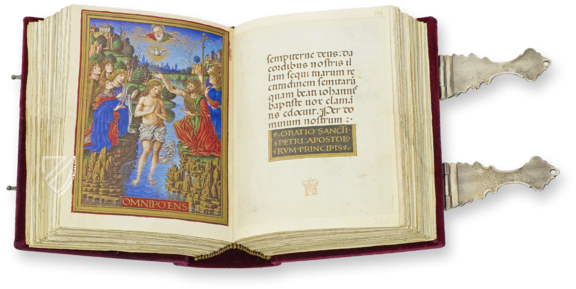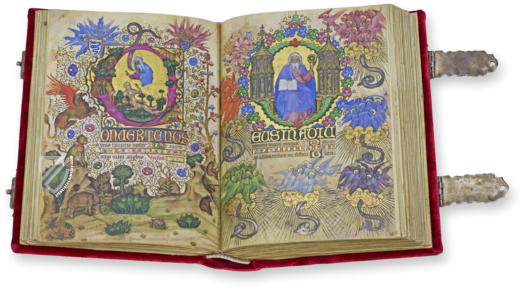Book of Hours of Galeotto Pico della Mirandola
(1,000€ - 3,000€)
The Mirandola Book of Hours originated between 1496 and 1499 in either Mantua or Ferrara, Italy and is a gem of Renaissance illumination. As Lord of Mirandola, Galeotto Pico I (1442–1499) commissioned the book, whose text for private devotion was appended by four full-page and seven smaller miniatures. Furthermore, its 228 pages contains a calendar with pictures of the months and zodiac signs, six initials with scenic depictions, 85 initials in front of lovely landscapes, and an additional 37 initials with inventive, extensive ornaments. The Italian Renaissance painter Giovanni Francesco Maineri, who was primarily employed by the Este family, is most likely responsible for this wealth of splendid paintings. Above all, the pages that are completely filled by luminous miniatures with richly detailed interior spaces invite closer inspection. David is also featured quite often, integrated into the letters in various postures and surrounded by their golden tendrils. Bordures beneath the text with a great variety of birds and deer correspond to their brilliant design.
Book of Hours of Galeotto Pico della Mirandola
An outstanding example of Renaissance illumination is found in the book of hours named after the city of Mirandola, which originated between 1496 and 1499 in Mantua or Ferrara. Its 228 pages contain four full-page and seven smaller miniatures, which illustrate the text of the book for private devotion. Furthermore, it contains a calendar with pictures of the months and zodiac signs, six initials with scenic depictions, 85 initials in front of lovely landscapes, and an additional 37 initials with lively, extensive ornaments**. Galeotto Pico I (1442–1499), the Lord of Mirandola, probably commissioned the marvelous work from the Italian Renaissance painter Giovanni Francesco Maineri, who primarily worked for the Este family.
A Fanciful Variety of Ornaments
The numerous initials, which either come before a scenic background with idyllic landscapes or in combination with elegant golden leafy foliage are particularly inventive. With regard to the historiated initials, it is above all the combination of deep blue and shimmering gold that enchants the beholder. They either rest on a small piece of ground, chained to a barren tree, or are animated to walk by little figurines. The iridescent birds often play on the frames artistically formed from branches for the smaller representations in the lower margin of the page.
Glimmering Miniatures
The four full-page miniatures mark the division of the main sections, which they respectively preface. The scene with the personification of death, which almost casually supports one hand on the hip and holds the scythe on the shoulder in the other, is simultaneously fascinating and eerie. Looking directly at the observer, the skeleton only wears a sort of sash in a magnificent architectural interior that stretches behind it. The frames for this painting consist of numerous death’s heads and slithering snakes. The Annunciation scene with the Angel Gabriel and the Virgin Mary is more carefree. God the Father is above the main scene, and below that is Adam and Eve together with the Tree of Paradise. It's amazing how lavish the use of gold is in these book paintings. Found in ornaments, dresses, and drapery, as well as the background, it contributes significantly to the divine and precious overall impression of the Mirandola Book of Hours.
Codicology
- Alternative Titles
- Libro d'ore di Galeotto Pico della Mirandola
Galeotto I Pico della Mirandola Book of Hours
Stundenbuch des Pico della Mirandola
Mirandola Stundenbuch - Size / Format
- 228 pages / 18.5 × 13.0 cm
- Origin
- Italy
- Date
- Between 1496 and 1499
- Epochs
- Style
- Genre
- Language
- Illustrations
- 4 large and 7 smaller miniatures, calender with miniatures of seasonal occupations and signs of the zodiac, 6 historiated initials, 85 Initial letters in front of landscape an 37 initials with large ornament
- Patron
- Galeotto Pico of Mirandola (1442–1499)
- Artist / School
- Giovanni Francesco Maineri
School of Ferrara - Previous Owners
- Galeotto I Pico della Mirandola and his wife
Michael Tomkinson
John Ruskin
Charles William Dyson Perrins
Book of Hours of Galeotto Pico della Mirandola
Crucifixion
The Three Marys are pictured lamenting at the base of the cross as Christ’s corpse hangs limply: the Virgin Mary, Mary Magdalene, and Mary of Clopas. All three are depicted with individual facial features, but all share the same look of shock and horror on their faces. The employment of gold leaf has been especially well executed, particularly the way in which it is used to highlight the wood grain of the cross. In the distant background, the skyline of Jerusalem can be seen.
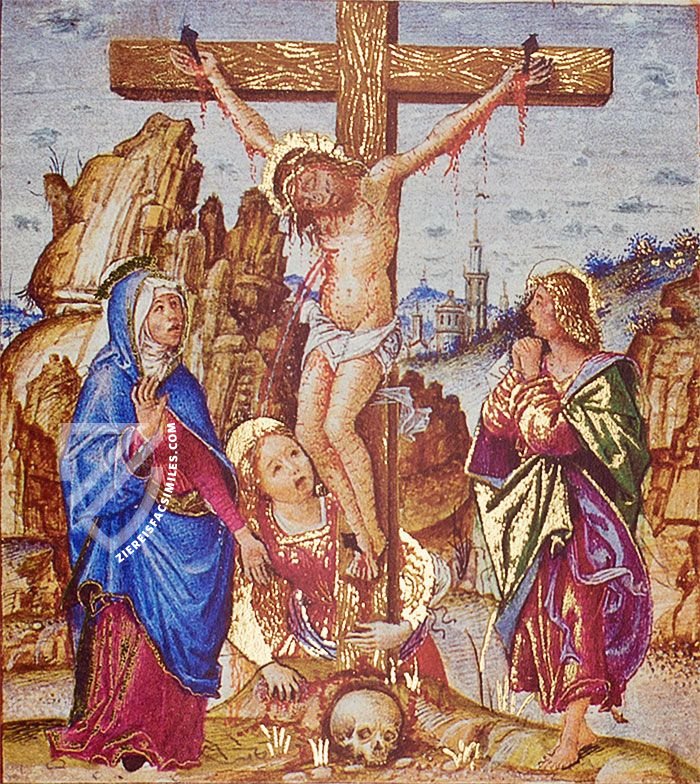
Book of Hours of Galeotto Pico della Mirandola
Incipit Page: Office of the Dead
This gorgeous yet eerie incipit page prefaces the prayers that are meant to be recited for the sake of the deceased, especially those in purgatory. As such, it is presented in a sea of macabre imagery in a burnished gold leaf frame with a blue border, which is filled with skulls, bones, snakes, miters, and cardinals’ hats. The text is written alternately in gold and blue ink by a skilled hand.
The primary miniature shows the personification of death looking directly at the beholder with a scythe slung over their shoulder and a black sash. Death is depicted in a magnificent interior with a hand on the hip and posed with quite a bit of swagger for being a skeleton. The medallion miniature at the bottom shows an angel proclaiming the Good News to the dead.

#1 Mirandola Stundenbuch
Languages: German
(1,000€ - 3,000€)
- Treatises / Secular Books
- Apocalypses / Beatus
- Astronomy / Astrology
- Bestiaries
- Bibles / Gospels
- Chronicles / History / Law
- Geography / Maps
- Saints' Lives
- Islam / Oriental
- Judaism / Hebrew
- Single Leaf Collections
- Leonardo da Vinci
- Literature / Poetry
- Liturgical Manuscripts
- Medicine / Botany / Alchemy
- Music
- Mythology / Prophecies
- Psalters
- Other Religious Books
- Games / Hunting
- Private Devotion Books
- Other Genres
- Afghanistan
- Armenia
- Austria
- Belgium
- Belize
- Bosnia and Herzegovina
- China
- Colombia
- Costa Rica
- Croatia
- Cyprus
- Czech Republic
- Denmark
- Egypt
- El Salvador
- Ethiopia
- France
- Germany
- Greece
- Guatemala
- Honduras
- Hungary
- India
- Iran
- Iraq
- Israel
- Italy
- Japan
- Jordan
- Kazakhstan
- Kyrgyzstan
- Lebanon
- Liechtenstein
- Luxembourg
- Mexico
- Morocco
- Netherlands
- Palestine
- Panama
- Peru
- Poland
- Portugal
- Romania
- Russia
- Serbia
- Spain
- Sri Lanka
- Sweden
- Switzerland
- Syria
- Tajikistan
- Turkey
- Turkmenistan
- Ukraine
- United Kingdom
- United States
- Uzbekistan
- Vatican City
- A. Oosthoek, van Holkema & Warendorf
- Aboca Museum
- Ajuntament de Valencia
- Akademie Verlag
- Akademische Druck- u. Verlagsanstalt (ADEVA)
- Aldo Ausilio Editore - Bottega d’Erasmo
- Alecto Historical Editions
- Alkuin Verlag
- Almqvist & Wiksell
- Amilcare Pizzi
- Andreas & Andreas Verlagsbuchhandlung
- Archa 90
- Archiv Verlag
- Archivi Edizioni
- Arnold Verlag
- ARS
- Ars Magna
- ArtCodex
- AyN Ediciones
- Azimuth Editions
- Badenia Verlag
- Bärenreiter-Verlag
- Belser Verlag
- Belser Verlag / WK Wertkontor
- Benziger Verlag
- Bernardinum Wydawnictwo
- BiblioGemma
- Biblioteca Apostolica Vaticana (Vaticanstadt, Vaticanstadt)
- Bibliotheca Palatina Faksimile Verlag
- Bibliotheca Rara
- Boydell & Brewer
- Bramante Edizioni
- Bredius Genootschap
- Brepols Publishers
- British Library
- C. Weckesser
- Caixa Catalunya
- Canesi
- CAPSA, Ars Scriptoria
- Caratzas Brothers, Publishers
- Carus Verlag
- Casamassima Libri
- Centrum Cartographie Verlag GmbH
- Chavane Verlag
- Christian Brandstätter Verlag
- Circulo Cientifico
- Club Bibliófilo Versol
- Club du Livre
- CM Editores
- Collegium Graphicum
- Collezione Apocrifa Da Vinci
- Comissão Nacional para as Comemorações dos Descobrimentos Portugueses
- Coron Verlag
- Corvina
- CTHS
- D. S. Brewer
- Damon
- De Agostini/UTET
- De Nederlandsche Boekhandel
- De Schutter
- Deuschle & Stemmle
- Deutscher Verlag für Kunstwissenschaft
- DIAMM
- Droz
- E. Schreiber Graphische Kunstanstalten
- Ediciones Boreal
- Ediciones Grial
- Ediclube
- Edições Inapa
- Edilan
- Editalia
- Edition Deuschle
- Edition Georg Popp
- Edition Leipzig
- Edition Libri Illustri
- Editiones Reales Sitios S. L.
- Éditions de l'Oiseau Lyre
- Editions Medicina Rara
- Editorial Casariego
- Editorial Mintzoa
- Editrice Antenore
- Editrice Velar
- Edizioni Edison
- Egeria, S.L.
- Eikon Editores
- Electa
- Emery Walker Limited
- Enciclopèdia Catalana
- Eos-Verlag
- Ephesus Publishing
- Ernst Battenberg
- Eugrammia Press
- Extraordinary Editions
- Fackelverlag
- Facsimila Art & Edition
- Facsimile Editions Ltd.
- Facsimilia Art & Edition Ebert KG
- Faksimile Verlag
- Feuermann Verlag
- Folger Shakespeare Library
- Franco Cosimo Panini Editore
- Friedrich Wittig Verlag
- Fundación Hullera Vasco-Leonesa
- G. Braziller
- Gabriele Mazzotta Editore
- Gebr. Mann Verlag
- Gesellschaft für graphische Industrie
- Getty Research Institute
- Giovanni Domenico de Rossi
- Giunti Editore
- Graffiti
- Grafica European Center of Fine Arts
- Guido Pressler
- Guillermo Blazquez
- Gustav Kiepenheuer
- H. N. Abrams
- Harrassowitz
- Harvard University Press
- Helikon
- Hendrickson Publishers
- Henning Oppermann
- Herder Verlag
- Hes & De Graaf Publishers
- Hoepli
- Holbein-Verlag
- Houghton Library
- Hugo Schmidt Verlag
- Idion Verlag
- Il Bulino, edizioni d'arte
- ILte
- Imago
- Insel Verlag
- Insel-Verlag Anton Kippenberger
- Instituto de Estudios Altoaragoneses
- Instituto Nacional de Antropología e Historia
- Istituto dell'Enciclopedia Italiana - Treccani
- Istituto Ellenico di Studi Bizantini e Postbizantini
- Istituto Geografico De Agostini
- Istituto Poligrafico e Zecca dello Stato
- Italarte Art Establishments
- Jan Thorbecke Verlag
- Johnson Reprint Corporation
- Josef Stocker
- Josef Stocker-Schmid
- Jugoslavija
- Karl W. Hiersemann
- Kasper Straube
- Kaydeda Ediciones
- Kindler Verlag / Coron Verlag
- Kodansha International Ltd.
- Konrad Kölbl Verlag
- Kurt Wolff Verlag
- La Liberia dello Stato
- La Linea Editrice
- La Meta Editore
- Lambert Schneider
- Landeskreditbank Baden-Württemberg
- Leo S. Olschki
- Les Incunables
- Liber Artis
- Library of Congress
- Libreria Musicale Italiana
- Lichtdruck
- Lito Immagine Editore
- Lumen Artis
- Lund Humphries
- M. Moleiro Editor
- Maison des Sciences de l'homme et de la société de Poitiers
- Manuscriptum
- Martinus Nijhoff
- Maruzen-Yushodo Co. Ltd.
- MASA
- Massada Publishers
- McGraw-Hill
- Metropolitan Museum of Art
- Militos
- Millennium Liber
- Müller & Schindler
- Nahar - Stavit
- Nahar and Steimatzky
- National Library of Wales
- Neri Pozza
- Nova Charta
- Oceanum Verlag
- Odeon
- Orbis Mediaevalis
- Orbis Pictus
- Österreichische Staatsdruckerei
- Oxford University Press
- Pageant Books
- Parzellers Buchverlag
- Patrimonio Ediciones
- Pattloch Verlag
- PIAF
- Pieper Verlag
- Plon-Nourrit et cie
- Poligrafiche Bolis
- Presses Universitaires de Strasbourg
- Prestel Verlag
- Princeton University Press
- Prisma Verlag
- Priuli & Verlucca, editori
- Pro Sport Verlag
- Propyläen Verlag
- Pytheas Books
- Quaternio Verlag Luzern
- Reales Sitios
- Recht-Verlag
- Reichert Verlag
- Reichsdruckerei
- Reprint Verlag
- Riehn & Reusch
- Roberto Vattori Editore
- Rosenkilde and Bagger
- Roxburghe Club
- Salerno Editrice
- Saltellus Press
- Sandoz
- Sarajevo Svjetlost
- Schöck ArtPrint Kft.
- Schulsinger Brothers
- Scolar Press
- Scrinium
- Scripta Maneant
- Scriptorium
- Shazar
- Siloé, arte y bibliofilia
- SISMEL - Edizioni del Galluzzo
- Sociedad Mexicana de Antropología
- Société des Bibliophiles & Iconophiles de Belgique
- Soncin Publishing
- Sorli Ediciones
- Stainer and Bell
- Studer
- Styria Verlag
- Sumptibus Pragopress
- Szegedi Tudomànyegyetem
- Taberna Libraria
- Tarshish Books
- Taschen
- Tempus Libri
- Testimonio Compañía Editorial
- Thames and Hudson
- The Clear Vue Publishing Partnership Limited
- The Facsimile Codex
- The Folio Society
- The Marquess of Normanby
- The Richard III and Yorkist History Trust
- Tip.Le.Co
- TouchArt
- TREC Publishing House
- TRI Publishing Co.
- Trident Editore
- Typis Regiae Officinae Polygraphicae
- Union Verlag Berlin
- Universidad de Granada
- University of California Press
- University of Chicago Press
- Urs Graf
- Vallecchi
- Van Wijnen
- VCH, Acta Humaniora
- VDI Verlag
- VEB Deutscher Verlag für Musik
- Verlag Anton Pustet / Andreas Verlag
- Verlag Bibliophile Drucke Josef Stocker
- Verlag der Münchner Drucke
- Verlag für Regionalgeschichte
- Verlag Styria
- Vicent Garcia Editores
- W. Turnowski Ltd.
- W. Turnowsky
- Waanders Printers
- Wiener Mechitharisten-Congregation (Wien, Österreich)
- Wissenschaftliche Buchgesellschaft
- Wissenschaftliche Verlagsgesellschaft
- Wydawnictwo Dolnoslaskie
- Xuntanza Editorial
- Zakład Narodowy
- Zollikofer AG

